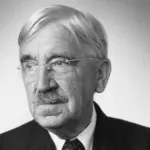
The term “Stream of Consciousness” was coined by William James at the end of the 19th century, to refer to how thoughts emanate and circulate in the conscious mind. Through this concept, James analyzed the wide variety of thoughts we are aware of and how they shape the flow of consciousness.
Next we will see what William James’ idea of the flow of consciousness consists of, what its attributes are and how our thoughts are shaped.
The Stream of Consciousness: background and definition
In 1889, the American William James published one of the works that establishes him as one of the fathers of psychology: “The Principles of Psychology.” In this book he explored and described consciousness in terms of a “flow” or “current,” that is, as a continuous succession of experiences through which we select or direct our attention toward certain stimuli.
Among other things, James had the concern, like many other scientists and philosophers of the time, of explore the contents of consciousness and know the way in which we carry out that complex action we call “thinking.” and what is more: how we realize (we become aware) that we are thinking.
He called it “flow” (streamin the original English), to make a metaphorical reference to a kind of caravan of ideas, images, feelings, sensations, thoughts, etc., that constantly appear and disappear in our consciousness.
According to this idea, all the previous elements, contrary to what used to be thought, are not so separated and differentiated from each other; They are part of the same conscious flow where past and current thoughts are connected. According to this way of understanding the human mind, consciousness is characterized by the constant passage of psychological contents, some linked to each other, and the existence of each of them cannot be understood separately, since they are united and overlap. each other.
There is then a superposition of our cognitive experiences where the current experience may be the easiest to recognize because it is immediate, but it happens that past experiences continue to become present, and the next ones gradually enter the flow.
That is, mental states follow one another. There are no “isolated thoughts”, but all of them are found in the same continuous stream of consciousness, regardless of temporality and even what we can anticipate or decide.
4 descriptive properties of the Stream of Consciousness
According to Tornay and Milan (1999), the four descriptive properties that James attributes to the flow of consciousness are the following:
How do we think?
William James said that consciousness, and more specifically thought, follows a process that appears to be necessarily directed by intelligence. However, according to the psychologist, the figure of the “thinker” does not necessarily have to manifest as a leader.
Rather, the action of thinking is a goal-oriented process, which is fundamentally driven by the feeling of satisfaction we experience when we are about to achieve those goals.
Thinking would then be an automated process that has been consolidated as a logical result of our evolution, that is, it does not want the existence of an independent or spiritual entity to guide this process. In other words, far from there being an entity (ourselves) separate from our consciousness, dictating the paths it follows; The conscious state is rather a process driven by our desire to experience satisfaction under the belief that our thoughts lead us to accomplish something.
Determinism and free will
Inevitably, some questions related to determinism and free will in human beings arise from this. We could quickly draw the conclusion that, for James, humans experience, feel and think as automatons.
Nevertheless, James suggests that human beings are, more than automatons, selecting organs. This is because, although we cannot consciously select what will initially appear in our consciousness, we can choose which element we keep there or not once it has become present; or to which stimulus we remain attentive and to which we do not.
Although this was a discussion present in much of his work, James moves the debate on free will towards the realms of philosophy, clarifying that psychology, as a science, should be added to a more deterministic tradition of consciousness.
How do William James’ ideas relate to advances in neuroscience?
The concept of Stream of Consciousness is no longer used in current Psychology (at least consistently), but rather is referred to as part of the History of this science and the works of William James. However, its essence seems to go in line with what the last decades of neuroscience research have allowed us to learn about the human mind.
For example, it is known that neural networks work by coordinating and overlapping each other, not from differentiated “brain modules” that work in parallel. Besides, The fact that one thought leads to the next is part of the normal activity of the nervous system and this is the way in which an inertia is generated that drives mental processes always forward, without allowing them to stagnate completely.








